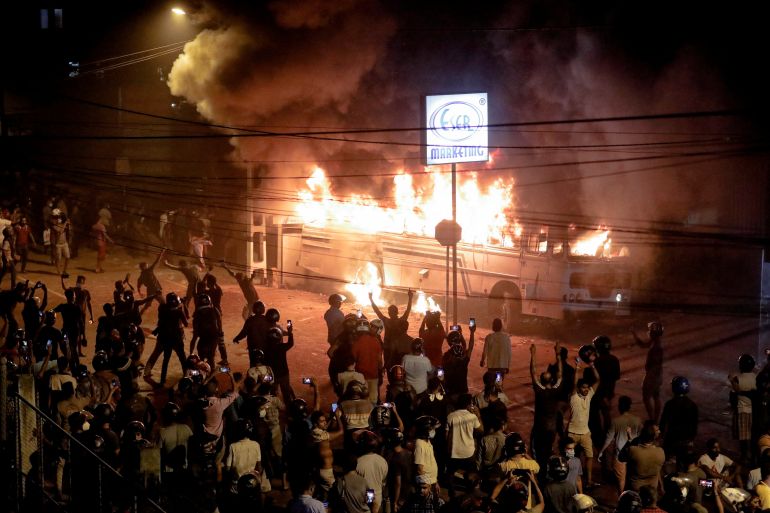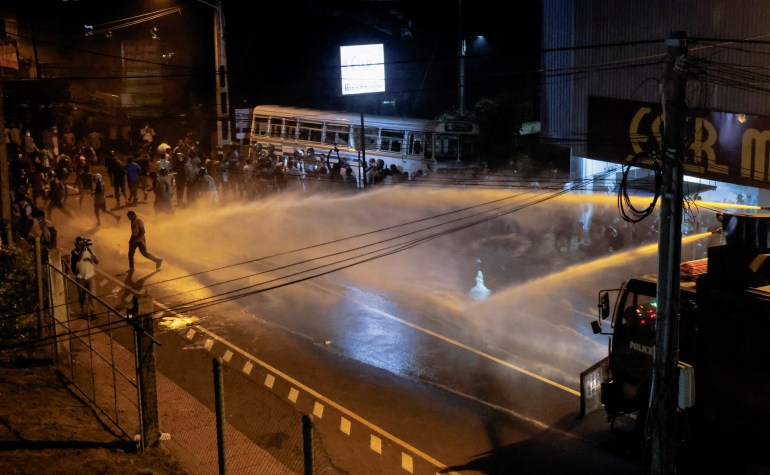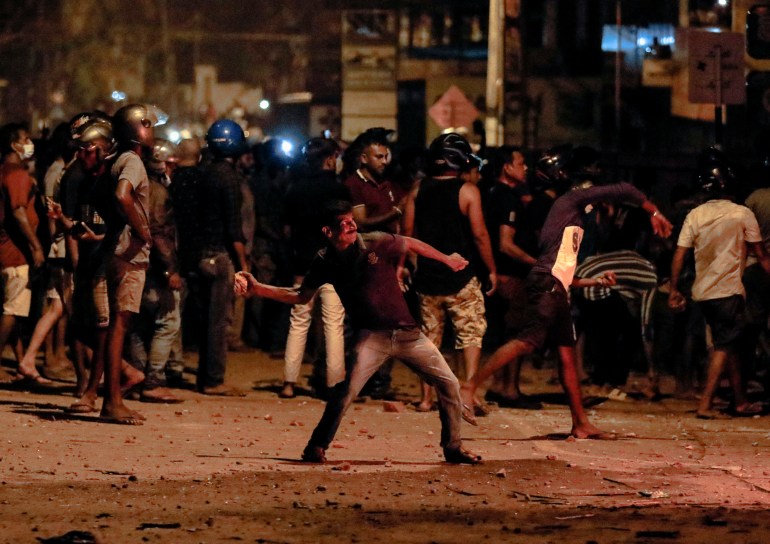Dozens arrested in Sri Lanka amid protests over worsening economy
Police also imposed a brief curfew after clashing with protesters who tried to storm President Gotabaya Rajapaksa’s house.

Colombo, Sri Lanka – Police in Sri Lanka have lifted an overnight curfew in the country’s capital after arresting dozens of people and quelling unrest that saw large crowds attempt to storm President Gotabaya Rajapaksa’s private residence amid anger over a worsening economic crisis.
At least 54 people were detained in Colombo’s Mirihana district in the early hours of Friday, the police said, branding the protesters as “organised extremists” trying to “create anarchy in the country”.
Keep reading
list of 4 itemsSri Lanka crisis forces 13-hour blackouts, hospitals stop surgery
As prices soar in crisis-hit Sri Lanka, many forced to moonlight
Sri Lanka seeks another $1bn from India: Report
Some of them “carried iron bars, sticks and sharp weapons” and tried to incite protesters to storm the president’s residence, it added.
Earlier on Thursday night, Al Jazeera witnessed hundreds of protesters in Mirihana throwing stones and clashing with police as they pushed through the first line of barricades blocking the road to Rajapaksa’s home.
The police responded with tear gas and water cannon as the crowds chanted “Go home Gota, go home!” and “Gota is a dictator”.
Videos from the protest site, posted by the News Wire outlet on Facebook, later showed a police bus on fire and protesters tending to a man with a bloodied face. Police said two military buses and a four-wheel drive were set ablaze.
It was not clear if the president was at his residence at the time.
A spokesperson for the police declined to comment.


The calls for Rajapaksa’s resignation came as Sri Lanka struggles with an economic downturn sparked by a foreign exchange crisis that has left the government unable to pay for imports of fuel, food, medicine and other essentials. The shortages have resulted in daily rolling blackouts for up to 13 hours in the island nation of 22 million people, and led to some state-run hospitals suspending routine surgeries.
Sri Lanka has turned to the International Monetary Fund for a bailout and is also seeking financial help from China and India. Beijing and New Delhi are reportedly each considering offering $1.5bn in credit facilities, on top of loans worth billions of dollars requested by Rajapaksa’s government.
The protests on Thursday were the latest in a series of nightly demonstrations in Colombo’s suburbs over the past week. The gathering began peacefully, with hundreds of people rallying a few streets away from Rajapaksa’s home.
“We came to protest the unbearable cost of living, fuel shortages and electricity cuts,” said 26-year-old Ajith Perera, who spoke to Al Jazeera before the police cracked down. “The decision to come to the president’s house was spontaneous. We want the president, who has caused so much destruction, to go home.”
Mohamed Asri, a 21-year-old protester, told Al Jazeera he travelled to Mirihana from another Colombo district after seeing coverage of the protest on local television channels.
“The economy is so bad that we can hardly eat two meals a day,” he said. “Things were never this bad in my lifetime. Gota has to go.”
‘Everyone is angry’
After the Mirihana gathering devolved into violence, protests spread throughout the city, with demonstrators using burning logs to block the main highway from Colombo to Sri Lanka’s second-biggest city, Kandy.
“I am angry, everyone is angry,” said protester Saman Wanasinghe. “Who knows what will happen now? There will be protests all over.”
But police – who were deployed to the capital’s streets in force – quickly quelled the unrest and Colombo was calm by dawn on Friday.
Analysts have said the economic crisis in Sri Lanka – which only emerged from a 26-year-long civil war in 2009 – stems from mismanagement by the Rajapaksa government during the COVID-19 pandemic. Despite an ill-timed tax break that depleted government coffers and border closures that resulted in the disappearance of tourism revenues, the government delayed seeking IMF help, they said.
Amid the inaction, Sri Lanka’s foreign exchange reserves dropped by 70 percent in two years, and annual inflation soared by up to 55 percent, according to some estimates.
Alan Keenan, a senior consultant at the International Crisis Group, said Thursday’s protest outside Rajapaksa’s house “was an unprecedented show of anger and defiance” against the president, who is feared by many, partly because he – as the former defence minister – spearheaded a bloody campaign that quashed a separatist rebellion by Sri Lanka’s ethnic Tamil minority.
The United Nations says Sri Lankan forces killed at least 40,000 Tamil civilians in the last days of the war, while rights groups also accuse Rajapaksa and his elder brother Mahinda, who was the president at the time, of overseeing a crackdown against those who opposed the military’s brutal tactics, including journalists and dissidents from the country’s Sinhalese Buddhist majority.
The Rajapaksas, who deny the allegations of rights abuses, lost power following an election in 2015 due to increased public anger about authoritarianism, nepotism and corruption. But they returned to power just four years later, with Gotabaya Rajapaksa winning the presidency after campaigning on a platform of improving security and tackling what he called “Muslim extremism” in the wake of a series of deadly ISIL-claimed attacks on churches and hotels in the country.
His brother Mahinda then became the prime minister. And their eldest brother was appointed agriculture minister while the youngest brother became the finance minister.
Keenan said Thursday’s protests indicated “a sea change in attitudes and willingness to take action” on the Sri Lankan public’s part.
But he cautioned that it was virtually impossible to remove Gotabaya Rajapaksa, as constitutional reforms in 2020 have given the president extraordinary powers while his party’s grip on parliament remained firm.
“With anger growing and inhibitions against violent protest falling away, the current situation is a very dangerous one, even as it contains potential seeds of democratic change,” Keenan said.
“Many fear the government could resort to violence – either directly or through a staged incident, perhaps designed to redirect popular anger against Muslims. Vigilance from influential governments and international bodies like the United Nations is thus essential.”
Rathindra Kuruwita reported from Colombo, Sri Lanka, while Zaheena Rasheed reported and wrote from Male, Maldives.